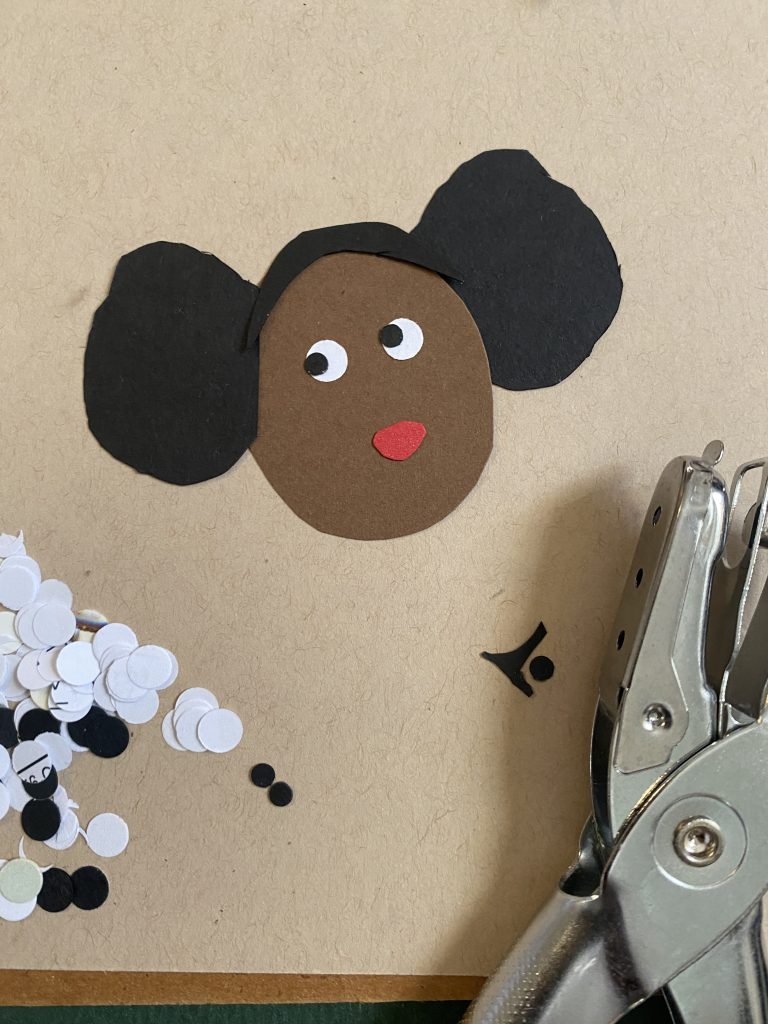Child’s Play

When I was a child in the early 70s, I was lucky my Mother bought me black dolls. Brown baby dolls that looked like me, and shared my dark skin color, my nose, my brown eyes. Later, I realized that I was fortunate because in my teenage years I met a young woman of color who never owned a doll that looked like her. We had both grown up in communities where light skin was praised and dark skin was tolerated. Self-love, something that should start at home with your parents and other adults in the community wasn’t always taught. It wasn’t necessarily neglectful, more that no one had taught them the importance of self-acceptance, these problems are sometimes passed from one generation to the next. Too often where we grew up, unconscious levels of self-hate permeated the minds of our teachers, coaches, and other influential adults.
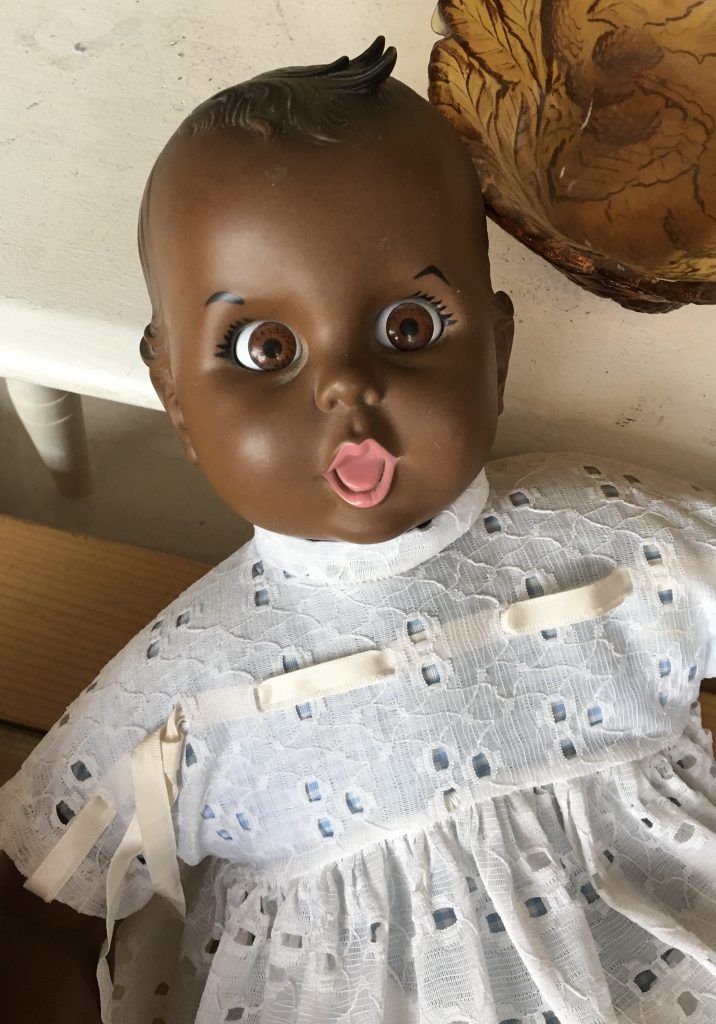
I remember a childhood friend who insisted that her fair-skinned doll looked exactly like her in every way. My friend was light brown, and while her permed hair was long, thick, and straight, she was several shades darker than her tiny friend. The situation would be resurrected later in life at a horrible make-up counter incident when a saleswoman decided to let her know that knew she was darker than the make-up. “Mama, the light foundation you’re looking at is totally wrong for you.” Embarrassing. Unnecessarily harsh, but in my experience, these scenarios were far too common.
Another hurtful incident happened right before a performance for a high school play. One of my fellow cast members was anxious because she’d misplaced her face powder. “You can borrow mine”, I said intending to calm her worries. She looked at me with a shocked expression and immediately said, “Roz, we can’t possibly share makeup, you’re much much darker than me!” I remember being stunned – no, flabbergasted – because we were not alone, the other mostly white kids in the room were as confused as I was. You see not only were we close in skin tone, but it was a High School play and we most likely would use exactly the same powder. Theatrical makeup for black people at that time didn’t offer a lot of choices. Embarrassed, I felt alone. I would eventually feel sorry for her because I later realized that slight differences in our skin tones mattered. It mattered so much to her that she needed me to know, wanted us all to know, that she was lighter than me, even if by a hair.

In another jarring experience I had with my doll was when I was 8 yrs old, I remember trying to get my older brother’s attention. He was trying to watch the football game but I wanted him to play with me, so I made my Barbie and Ken kiss and dance, right in front of the TV screen. Suddenly, he grabbed the girl doll by the hair and twisted off her head. It made a “POP” sound and I screamed. He then flung the beheaded corpse out of the back door. It landed on the roof of our carport.
This was a clear signal that we wouldn’t be playing together anymore. I cried out for my Mom, and she reprimanded him, but since there was no retrieving my doll from the flat roof, that was that. She told me to leave him alone and she turned and left the den. I retreated to my room in tears and my brother went back to watching America’s favorite pastime. I think moments like this explain why at an early age, I lost interest in watching contact sports with my family. Incidents like these have had an indelible impact on the choices I’ve made when making when making my artwork, especially when making dolls.
————————————
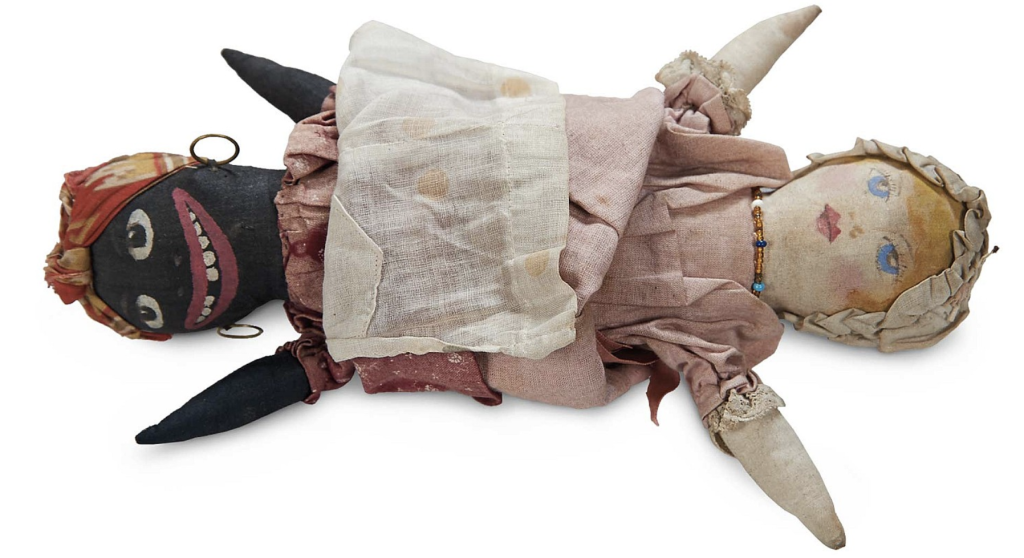
I’ve always been fascinated by topsy-turvy dolls. Who came up with the idea of making a toy that is both black and white? These dolls were usually designed as a two-in-one figure that was split in two at the waist. The doll had a long skirt that draped over the other side so that only one side of the toy was visible at a time, the other side was hidden underneath the skirt, clever. The white side of the doll was often blue-eyed, with blonde pigtails and a proper high-end period dress or skirt, and her skin was usually beige or pink. The black side was often designed with pickaninny hair, perhaps a simple apron, cheap skirt or uniform, and wide white eyes against the blackest of black fabrics. I can’t imagine what powder kegs of emotions, fights, and troubled conversations a toy like this would bring to the average plantation household. I can’t imagine the anger and fear the black parents might experience while having no control over the situation. What did these dolls teach young children? I would guess that most learned from an early age that being white was superior.
In my art practice, I’ve created many topsy-turvy dolls with a modern twist, dolls I’d like to see, and dolls I’d like young girls to play with. I’ve created a doll that was designed as a nod to the young people of the 60s and 70s. The black side of the doll wears an African dress with a matching head wrap. I chose fabric that mirrored the dark brown skin tones of people I know. She also proudly wears earrings. Her white counterpart is sporting a short red bob cut, a brightly colored floral pattern, and her skin is taupe. I also created some topsy-turvy dolls that were black on both sides. These dolls were made to depict different types of black women. I built one oversized black Topsy Turvey doll where one side of the doll was a black activist sporting an Afro and a raised fist wearing a skirt made of authentic African print with the word VOTE written across her chest. Her counterpart, also black wears a peaceful expression, a knit cap, and a simple printed cotton skirt in contrast to her sister, her hands are clasped gently in front of her and the message across her chest is LOVE. These are two sides of the same person. By pushing back on the traditional, stereotypical designs of the topsy turvy doll, I hope to disrupt the racist connotations of the doll and assert a sense of liberation, multiplicity, and humanity.
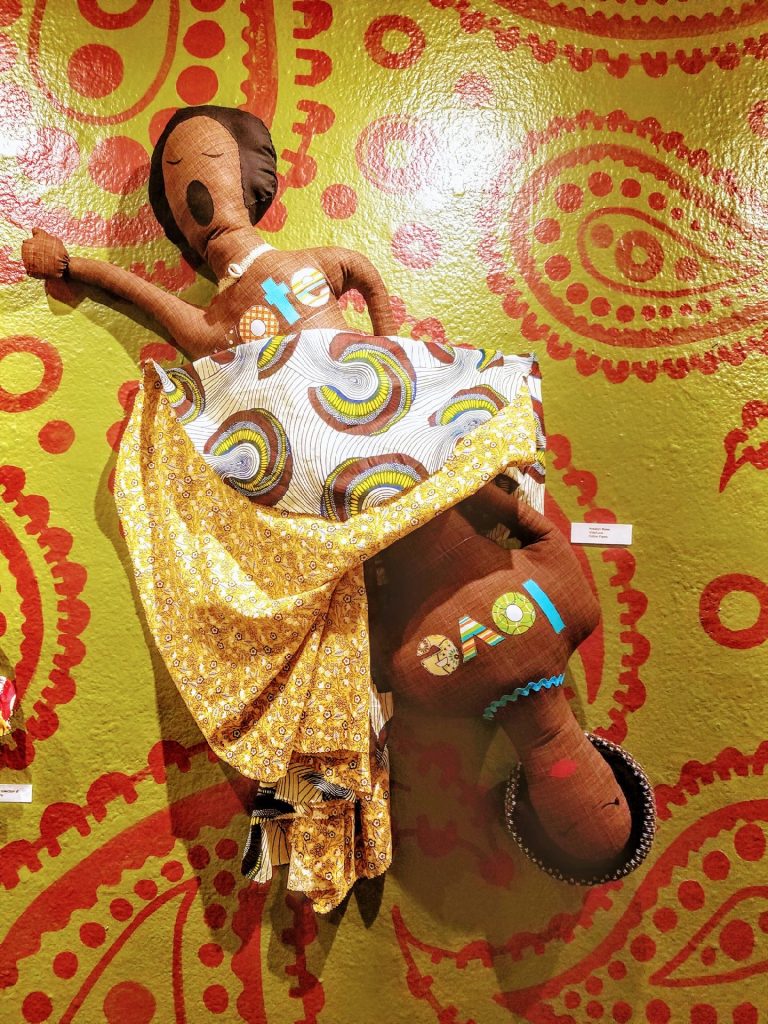
——————————————
I am not sure exactly when I became aware that race was an issue in our society, that being “black” could be problematic and make things harder, unfair. I grew up in a mostly black lower middle-class neighborhood (in Los Angeles). Our parents were teachers, technicians, and government employees. People worked hard and bought modest homes with green lawns and a car in the driveway. There were a few white families and a few Hispanic families in our hood, (though the white families would gradually leave by the 80s.) I do remember what set us apart from most of the people I saw on TV… our hair. Hair seemed to be the big dividing line between us and the rest of the world. Doing hair was not my mother’s strong suit, she wore wigs and kept her hair braided most of the time. I went to the beauty shop to get my hair processed. When I was a kid, most black girls had their hair chemically straightened or pressed. I only witnessed radical teenagers and black children from other countries wearing their hair in natural styles. Years later we would learn that the chemicals used in these straightening products have likely contributed to the large numbers of black women developing ovarian cancer.
My elderly neighbor Miss Hall used to press my hair with a hot comb. She would heat a metal comb (specially designed for this purpose) on the eye of the stove. Small amounts of oil would be applied to the hair and the hot comb pulled through, one section at a time. The heat from the comb would straighten out the kinks and like magic, your hair was straight. It was an act of love and she would lay it all down but she would also light up your ear. So many of the girls in my neighborhood had ritualistic tribal scars on the top of our ears and the back of our necks from sudden movements and slippery head grease. To complicate matters even more, I was a swimmer. I grew up swimming at the park across the street, my brother, (the doll killer) also swam and broke all kinds of records. Of course, my brother didn’t have to be concerned about his hair every time he entered the water. This concern led to me perming my hair so that I was free to swim without washing away my straight hair every time I swam. This was one of the reasons many of my female friends didn’t want to swim in the pool or the ocean. These hair straightening practices, though much improved continue to this day. My brother became a lifeguard and a diver. I still swim for exercise and I love to swim in the ocean. We even got my Mom to take lessons and learn to swim, a rarity at the time for a black woman her age.
As you might imagine swimming took a toll on my hair, I did what I could, I was only 10 years old. Many of the kids in my neighborhood would point out that I was getting darker every summer and that by continuing to swim I must have thought I was a white girl. I was quick to spit back, “I don’t care how black I get” and “White people don’t own the pool or the right to swim.” This would often end in me being beaten up by an even darker kid who thought that by beating my defiant commentary out of me, they might somehow appease the gods and appear lighter. This scenario is so unhealthy, kind of debilitating. Sadly, being young and black in this country can be challenging. Navigating self-hate can be messy.

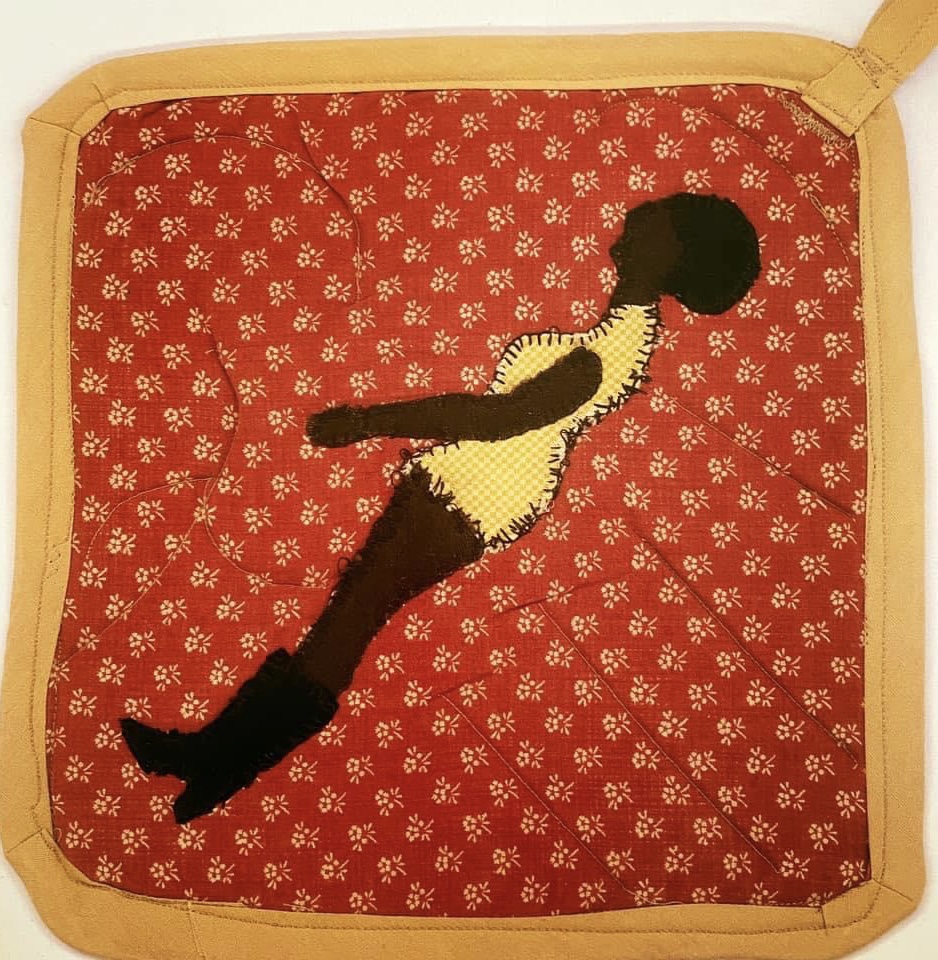
In College, I became aware of new natural ways of dealing with my hair. I learned there were healthy ways that work to strengthen your hair instead of using chemicals that weaken and damage our hair in an attempt to have straight silky hair. Locks and braids were a revolution, they were..are a source of freedom. I aim to be very deliberate about how I construct and represent authentic Black hair and Black hairstyles. I want to make sure that my work reflects the diversity of our hair. I use yarn, rope, paper, and even curled wire. Some of the dolls wear authentic headwraps, some have Afros. It is important that our standard of beauty is flexible, that there is variety.
——————————
Some of the oldest, still surviving dolls, can be found from many parts of the world, revealing that we’ve been making representations of ourselves since the dawn of time. People of color have used their hands to craft dolls out of available materials, making the process of doll-making accessible to all regardless of education or means.
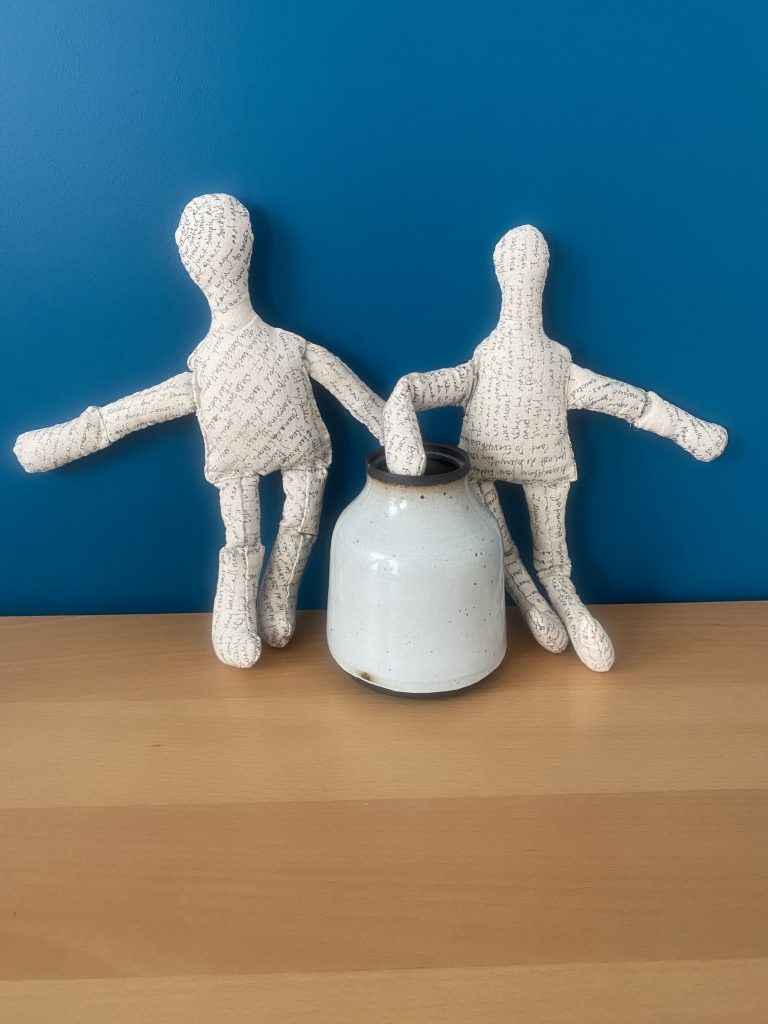
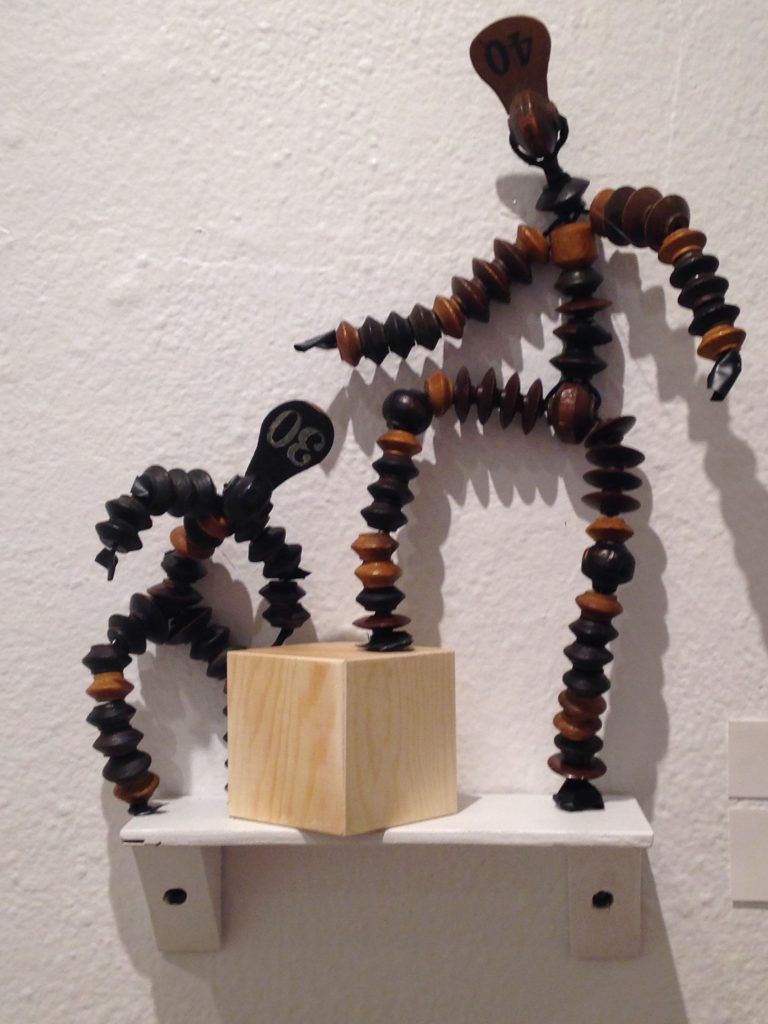
For me, the most important dolls are Rag Dolls. In the Antebellum South, these dolls were hand-sewn and made from reconstructed ticking and flour sack bags. They were usually stuffed with straw or cotton harvested by generations of slaves. I am in awe of the many approaches to doll-making on the continent. In many African countries, it is common practice to use recycled goods, plastic jugs, tin cans, and clay, nothing goes to waste. When they slaughter animals they use the entire animal, sometimes incorporating their hair and teeth or bones into their rituals and doll-making. It’s my intention when building representations of the black body that I honor these traditions and be mindful of how impactful a positive example can be and the powerful effect it can have on our emotions.

Like many artists, I use my art practice to express different aspects of my life. Some work touches on my pain, worries, and concerns about humanity. Some work expresses my joy, hopefulness, and love of life. I am a multidisciplinary artist weaving our histories and stories into installations that hopefully give the viewer a glimpse into the black experience. These stories about experiences with racial inequalities have informed my art practice. I am working to promote and celebrate the power of black skin, black hair, and black awareness.
Textiles, paper, collage, and photography are often my tools of choice, but I have always returned to making dolls. Dolls are the best vehicle for expressing my most cherished beliefs: that we are all created equal and that in our diverse ways, we are all incredibly beautiful and all of our stories are important.
I believe playing with black dolls helped me build positive self-esteem and opened my mind to the infinite possibilities that a healthy imagination has to offer. Most importantly, I believe that playing with black dolls can free black girls everywhere to appreciate their beauty, celebrate their individuality, and cherish their limitless creativity.
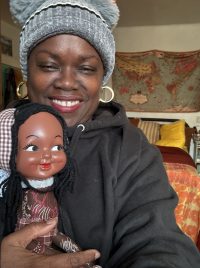
Rosalyn Myles is a multidisciplinary artist who lives in Los Angeles. In her practice, she works in several mediums: textiles, sculpture, paper, and photography. Her dolls explore stories about the black body, its many colors and shapes, the hair, and the colorful self-expression. Her work has been shown in Museums, Art Centers, and professional galleries in the US and abroad. She did undergraduate studies at Mills College and Cal State Dominguez Hills. Rosalyn completed her graduate studies at California College of the Arts in San Francisco. www.rosalynmylesart.com

